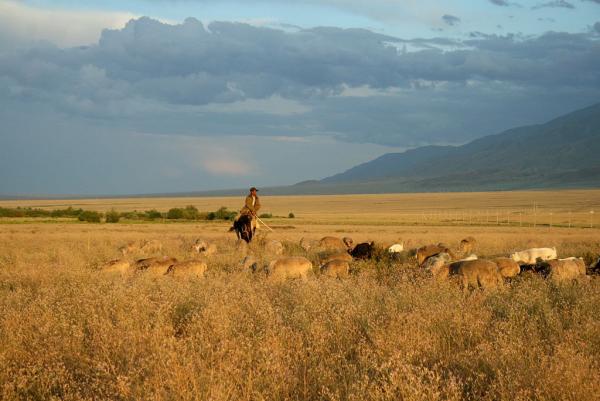The study, deeply grounded in genetic mapping, builds from our understanding of the genetic underpinning of MS into gene-environmental interactions both now and in the Bronze Age. The Bronze Age was named for the cultural transition from flint to bronze tools around 2,000 BC to 700 BC. From the point of view of the researchers:
“The late Neolithic and Bronze Age were a time of massively increased prevalence of infectious diseases in human populations, owing to increased population density as well as contact with, and consumption of, domesticated animals and their products.”
For the TL: DR [1] amongst us, the bottom line is that MS, like sickle cell disease (SCD), has its origins in protecting us from pathogens. [2] Like SCD, MS is believed to be “triggered” by exogenous factors in the genetically vulnerable. Like SCD, MS shows a propensity for an ethnic group, in this instance, those of European genetic ancestry rather than African. These underlying genetic alterations with our “urge to merge” [3] are responsible for the variations we see in the global prevalence of MS.
Prior studies have identified many genetic variants associated with MS, a sizeable portion found in the HLA region of our genes, the genes that aid the immune system’s ability to differentiate between foreign invaders and our body's tissue. The strongest associated HLA gene results in a 3-fold increase in the risk of MS. While genetics accounts for about 30% of overall risk, environment and lifestyle account for the remaining 70%. The example used by the researchers involves the Epstein-Barr virus, a frequent pathogen in children. However, when infection occurs in early adulthood, those individuals experience a 32-fold increase in the risk of MS.
Our genetic ancestors
There are many ways to trace our ancestry. In this instance, the researchers categorized lifestyle: “western hunter-gatherers (WHG), eastern hunter-gatherers (EHG), Caucasus hunter-gatherers (CHG), farmers (Anatolian (ANA) + Neolithic) and steppe pastoralists.” Using a dataset of genomic data from 318 individuals from the Bronze Age, they sought out similar present-day European genetics in 410,000 individuals in our old friend, the UK Biobank.
Two genetic regions stood out as “having the most extreme ancestry compositions,” the one of greatest interest being an HLA region on chromosome 6 “strongly associated with autoimmune diseases.” Using a variety of techniques that, to be honest, I grasped weakly; the researchers concluded that the genetic alterations most associated with MS were to be found
“…in modern populations from Finland, Sweden and Iceland and in ancient populations with a high proportion of steppe ancestry.” [4]
In fact, steppe ancestry conferred the greatest risk of all these lifestyle categorizations of ancestry. Why would these genes have thrived and been conserved over time? MS provides no survival advantage then or now. They found that the mutations
“…were associated with protective effects against specific pathogens and/or infectious diseases.”
That included EBV, varicella-zoster virus, mumps, influenza, parasites, Clostridioides difficile, Streptococcus pyogenes, Mycobacterium tuberculosis, and coronavirus. The researchers hastened to point out that these associations were suggestive and that the study was not sufficiently powered to reach statistical confidence.
Co-evolution
While it may not be readily apparent, we continue to co-evolve as our environment changes. There is an inherent mismatch in the time frame of genetic and environmental changes that characterize the Anthropocene. Evolution involves our genes, which we may regard as stable and conserved over long periods. But epigenetics, which includes a variety of ways cells turn genes on and off in response to our environment without altering our DNA, is a faster form of adaptation or evolution impacting how well we can accommodate our current environmental niche. Co-evolution describes the dance between our genes and environment, a dance both long and short.
Long before our more recent concerns about what is in our air or microplastics, or the possible effects of screentime, pathogens have been our fellow travelers – their influence on our genes is far older and perhaps more profound. As the researchers write:
“Our interpretation of this history is that co-evolution between a range of pathogens and their human hosts may have resulted in massive and divergent genetic ancestry-specific selection on immune response genes according to lifestyle and environment…”
It may well be that enhanced hygiene (as described in the hygiene hypothesis) along with lifestyle choices “no longer favours the previous genetic architecture” and has resulted in the increases we have seen in autoimmune diseases and the stable presence of other diseases such as sickle cell disease. Conventional history suggests that one of the “greatest lifestyle change[s] in human history” was the emergence of farming during the Bronze Age. From the perspective of immune history, it may well have been the “emergence of the pastoralist steppe lifestyle,” and its genetic impact lying until recently silent in our genes.
[1] Too Long: Didn’t Read
[2] Sickle cell disease results in sickle-shaped red blood cells that result in many microclots clogging up arteries. The misshapen cells are a hostile environment for the Malaria pathogen, preventing it from infecting individuals
[3] Thank you, Curtis Sliwa
[4] According to at least one website, Ms. Applegate does have some Swedish heritage.
Source: Elevated genetic risk for multiple sclerosis emerged in steppe pastoralist populations Nature DOI:10.1038/s41586-023-06618-z




